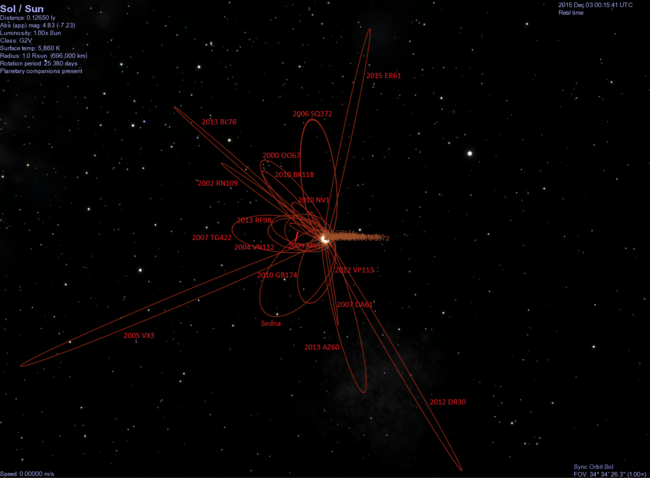2005 VX3
2005 VX3 is trans-Neptunian object and retrograde damocloid on a highly eccentric, cometary-like orbit. It was first observed on 1 November 2005, by astronomers with the Mount Lemmon Survey at the Mount Lemmon Observatory in Arizona, United States. The unusual object measures approximately 7 kilometers (4 miles) in diameter.[4] It has the 3rd largest known heliocentric semi-major axis and aphelion.[6] Additionally its perihelion lies within the orbit of Jupiter, which means it also has the largest orbital eccentricity of any known minor planet.
| Discovery [1][2] | |
|---|---|
| Discovered by | Mount Lemmon Srvy. |
| Discovery site | Mount Lemmon Obs. (first observed only) |
| Discovery date | 1 November 2005 |
| Designations | |
| 2005 VX3 | |
| TNO [3] · damocloid [4] unusual [5] · distant [1] | |
| Orbital characteristics [3] | |
| Epoch 27 April 2019 (JD 2458600.5) | |
| Uncertainty parameter 4 | |
| Observation arc | 81 days |
| Aphelion | 1825.61 AU |
| Perihelion | 4.1058 AU |
| 914.86 AU | |
| Eccentricity | 0.9955 |
| 27,672 yr | |
| 0.1730° | |
| 0° 0m 0s / day | |
| Inclination | 112.22° |
| 255.35° | |
| 196.37° | |
| Jupiter MOID | 0.8884 AU |
| TJupiter | −0.9430 |
| Physical characteristics | |
Mean diameter | 7 km (est.)[4] |
| 0.09 (assumed)[4] | |
| 14.1[1][3] | |
Description
2005 VX3 orbits the Sun at a distance of 4.1–1,826 AU once every 27,672 years (semi-major axis of 915 AU). Its orbit has an eccentricity of 0.9955 and an inclination of 112° with respect to the ecliptic. It belongs to the dynamical group of damocloids due to its retrograde orbit and its low Tisserand parameter (TJupiter of −0.9430).[3] It is a Jupiter-, Saturn-, Uranus-, and Neptune-crosser. The body's observation arc begins with its first observation by the Mount Lemmon Survey on 1 November 2005.[1]
| Orbital evolution — Barycentric elements | |||
| Year[7] (epoch) | Aphelion | Semimajor-axis | Ref |
|---|---|---|---|
| 1950 | 2710 AU | n.a. | [lower-alpha 1] |
| 2012 | 1914 AU | n.a. | [lower-alpha 2] |
| 2015 | 2563 AU | n.a. | [lower-alpha 3] |
| 2016 | 3235 AU | n.a. | [lower-alpha 4] |
| 2050 | 2049 AU | 1026 AU | [lower-alpha 1] |
2005 VX3 has a barycentric semi-major axis of ~1026 AU.[7][lower-alpha 1] 2014 FE72 and 2012 DR30 have a larger barycentric semi-major axis. The epoch of January 2016 was when 2005 VX3 had its largest heliocentric semi-major axis.
The object has a short observation arc of 81 days and does not have a well constrained orbit.[3] It has not been observed since January 2006, when it came to perihelion, 4.1 AU from the Sun.[3] It may be a dormant comet that has not been seen outgassing. In the past it may have made closer approaches to the Sun that could have removed most near-surface volatiles. The current orbit crosses the ecliptic just inside Jupiter's orbit and has a Jupiter-MOID of 0.8 AU.[3]
In 2017, it had an apparent magnitude of ~28 and was 24 AU from the Sun. It comes to opposition in mid-June. It would require one of the largest telescopes in the world for any more follow-up observations.
Comparison

Notes
- Given the orbital eccentricity of this object, different epochs can generate quite different heliocentric unperturbed two-body best-fit solutions to the semi-major axis and orbital period. For objects at such high eccentricity, the Sun's barycentric coordinates are more stable than heliocentric coordinates.[8] Using JPL Horizons, the barycentric semi-major axis is approximately 1026 AU.[7]
References
- "2005 VX3". Minor Planet Center. Retrieved 20 November 2018.
- "MPEC 2005-V58 : 2005 VX3". IAU Minor Planet Center. 8 November 2005. Retrieved 20 November 2018. (K05V03X)
- "JPL Small-Body Database Browser: (2005 VX3)" (2006-01-21 last obs.). Jet Propulsion Laboratory. Retrieved 20 November 2018.
- Johnston, Wm. Robert (7 October 2018). "List of Known Trans-Neptunian Objects". Johnston's Archive. Retrieved 19 November 2018.
- "List Of Other Unusual Objects". Minor Planet Center. 14 November 2018. Retrieved 19 November 2018.
- "JPL Small-Body Database Search Engine: Asteroids and a > 100 (AU)". JPL Solar System Dynamics. Retrieved 6 March 2014. (Epoch defined at will change every 6 months or so)
- Horizons output. "Barycentric Osculating Orbital Elements for 2005 VX3". Retrieved 6 March 2014. (Solution using the Solar System Barycenter and barycentric coordinates. Select Ephemeris Type:Elements and Center:@0)
- Kaib, Nathan A.; Becker, Andrew C.; Jones, R. Lynne; Puckett, Andrew W.; Bizyaev, Dmitry; Dilday, Benjamin; et al. (April 2009). "2006 SQ372: A Likely Long-Period Comet from the Inner Oort Cloud". The Astrophysical Journal. 695 (1): 268–275. arXiv:0901.1690. Bibcode:2009ApJ...695..268K. doi:10.1088/0004-637X/695/1/268.